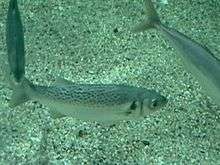Spotted seabass
The spotted seabass, Dicentrarchus punctatus, is a species of temperate bass native to marine and brackish waters of the coastal eastern Atlantic Ocean from the English Channel to the Canary Islands and Senegal, as well as through the Mediterranean Sea.
| Spotted seabass | |
|---|---|
 | |
| Scientific classification | |
| Kingdom: | Animalia |
| Phylum: | Chordata |
| Class: | Actinopterygii |
| Order: | Perciformes |
| Family: | Moronidae |
| Genus: | Dicentrarchus |
| Species: | D. punctatus |
| Binomial name | |
| Dicentrarchus punctatus (Bloch, 1792) | |
| Synonyms | |
| |
Habitat
The spotted seabass generally lives in brackish water at depths below approximately 30 meters.[2] It generally lives in subtropical waters, ranging from the coast of Brittany in the north to the coast of Africa and the Canary Islands in the south and also encompassing almost all of the coastline of the eastern Mediterranean Sea and going as far west as the Azores.[2]
Description
The spotted seabass can grow up to a size of about 70 cm; however, it usually only reaches a size of about 30 cm.[2] It is a silver-gray fish covered in black spots and also has a blue back whilst alive.[2][3] These black spots are only found on the adults; as well, the opercle has a rather large black spot.[3]
Biology
The spotted seabass is almost exclusively carnivorous. Its diet is largely composed of shrimp and molluscs; additionally, it at times eats smaller fish than itself.[2][3] The spotted seabass breeds at various times based on geography; in the Mediterranean it generally spawns from January until March whereas in the English Channel and other northern areas this range is from March until May.[3]
| Wikispecies has information related to Spotted seabass |
References
- Carpenter, K.E.; Smith-Vaniz, W.F.; de Bruyne, G.; de Morais, L. (2015). "Dicentrarchus punctatus". The IUCN Red List of Threatened Species. 2015: e.T198671A21913001. doi:10.2305/IUCN.UK.2015-4.RLTS.T198671A21913001.en. Retrieved 13 August 2019.
- "Dicentrarchus punctatus summary page". FishBase. Retrieved 10 June 2015.
- "Marine Species Identification Portal : European seabass - Dicentrarchus punctatus". species-identification.org. Retrieved 10 June 2015.
